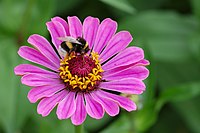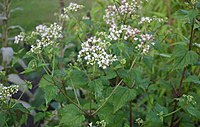Bloom Clock/Keys/Southeastern Pennsylvania/October/White Flowers/Herbaceous/Simple Leaves/Opposite Leaves

This page is part of a dichotomous key for plants recorded as blooming in Southeastern Pennsylvania during the month of October.
These plants have the following traits:
- White flowers
- are herbaceous
- simple leaves
- opposite leaves
Lobularia maritima
 Wikipedia • Commons • Wikibooks (horticulture) • Wikibooks (subject) • Wikispecies • Fruit and seed clock |
Profile for Lobularia maritima (Sweet Alyssum)
Recent Logs[edit | edit source]
| ||
Global data:
Temperate zone season(s): Early Summer, Late Summer, Mid Fall, Late Fall
Salvia nemorosa
 Wikipedia • Commons • Wikibooks (horticulture) • Wikibooks (subject) • Wikispecies • Fruit and seed clock |
Profile for Salvia nemorosa (Purple Sage)
Recent Logs[edit | edit source]
| ||||||||||||
Global data:
Temperate zone season(s): Late Spring, Early Summer, Mid Summer, Late Summer, Mid Fall
Saponaria officinalis
 Wikipedia • Commons • Wikibooks (horticulture) • Wikibooks (subject) • Wikispecies • Fruit and seed clock |
Profile for Saponaria officinalis (Soapwort)
Recent Logs[edit | edit source]
| ||||||||
Global data:
Temperate zone season(s): Late Spring, Early Summer, Mid Summer, Late Summer, Early Fall, Mid Fall
Mentha suaveolens
 Wikipedia • Commons • Wikibooks (horticulture) • Wikibooks (subject) • Wikispecies • Fruit and seed clock |
Profile for Mentha suaveolens (Apple Mint)
Recent Logs[edit | edit source] | ||||||||||||
Global data:
Pentas lanceolata
 Wikipedia • Commons • Wikibooks (horticulture) • Wikibooks (subject) • Wikispecies • Fruit and seed clock |
Profile for Pentas lanceolata (Pentas)
This page contains recent bloom logs for the plant Pentas lanceolata (Pentas). If you saw this plant blooming today (or sometime within the last 3 days), you can help improve the bloom clock by logging it. Just click on "edit" next to the Recent Logs heading, add *~~~~ (an asterisk followed by four tildes) on a new line just below the last signature, and then click "save page". This will add your signature and the date to log the plant. Please make sure you've signed up on the contributors' page so that we can know the location of the plant you saw blooming and use your contribution to create a flora for your region! When you're done, you can go back to one of the main pages and find logs of other flowers you might have seen today.
Recent Logs[edit | edit source]Archived Logs[edit | edit source](If there are more than 5 signatures under the recent logs heading, move the oldest logs to under this heading (generally leave the 3 most recent).
| ||
Global data:
Zinnia violacea
 Wikipedia • Commons • Wikibooks (horticulture) • Wikibooks (subject) • Wikispecies • Fruit and seed clock |
Profile for Zinnia violacea (Zinnia)
Recent Logs[edit | edit source] | ||
Global data:
Agastache foeniculum
 Wikipedia • Commons • Wikibooks (horticulture) • Wikibooks (subject) • Wikispecies • Fruit and seed clock |
Profile for Agastache foeniculum (Wild Hyssop)
Recent Logs[edit | edit source] | ||||||||||
Global data:
Pycnanthemum tenuifolium
 Wikipedia • Commons • Wikibooks (horticulture) • Wikibooks (subject) • Wikispecies • Fruit and seed clock |
Profile for Pycnanthemum tenuifolium (Small-leaved Mountain Mint)
Recent Logs[edit | edit source] | ||||||||||||
Global data:
Temperate zone season(s): Mid Summer, Late Summer, Mid Fall
Pycnanthemum incanum
 Wikipedia • Commons • Wikibooks (horticulture) • Wikibooks (subject) • Wikispecies • Fruit and seed clock |
Profile for Pycnanthemum incanum (Mountain Mint)
Recent Logs[edit | edit source] | ||||||||||||
Global data:
Temperate zone season(s): Mid Summer, Late Summer, Early Fall, Mid Fall
Galinsoga parviflora
 Wikipedia • Commons • Wikibooks (horticulture) • Wikibooks (subject) • Wikispecies • Fruit and seed clock |
Profile for Galinsoga parviflora (Gallant Soldier)
Recent Logs[edit | edit source] | ||
Global data:
Eupatorium rugosum
 Wikipedia • Commons • Wikibooks (horticulture) • Wikibooks (subject) • Wikispecies • Fruit and seed clock |
Profile for Eupatorium rugosum (White Snakeroot)
Recent Logs[edit | edit source] | ||
Global data:
Euphorbia maculata
 Wikipedia • Commons • Wikibooks (horticulture) • Wikibooks (subject) • Wikispecies • Fruit and seed clock |
Profile for Euphorbia maculata (Creeping Spurge)
Recent Logs[edit | edit source] | ||
Global data:
Lobelia siphilitica
 Wikipedia • Commons • Wikibooks (horticulture) • Wikibooks (subject) • Wikispecies • Fruit and seed clock |
Profile for Lobelia siphilitica (Blue Lobelia)
Recent Logs[edit | edit source] | ||
Global data:
Temperate zone season(s): Mid Summer, Late Summer, Early Fall, Mid Fall, Late Fall

